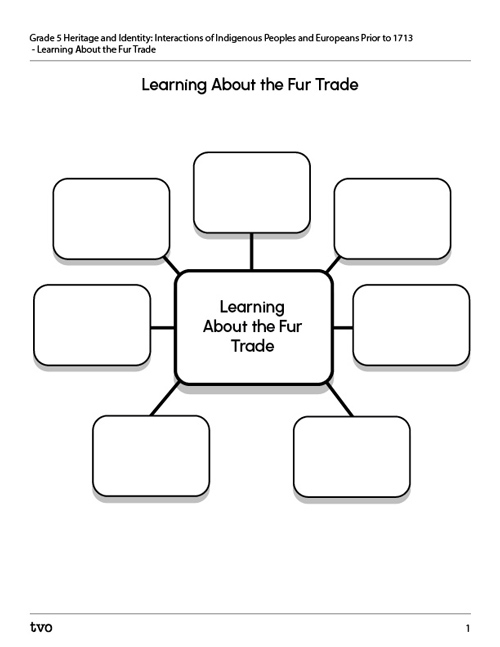Minds On
Products
Let’s begin by considering some items or products that are commonly used in our world.
Consider and respond to the following questions.
- Where do you think the parts from each product come from – one place or many places?
- Who desires these products? How does this demand make these products desirable and popular?
Action
Task 1: What was the fur trade?
Just like cell phones, chocolate bars, and gaming consoles are popular today, hats and other items made from beaver pelts were in demand in the 1600s and 1700s in Europe.

As a result, the timber trade, fishing, and most importantly, the fur trade became the main link between Europeans (French and British) and First Nations peoples across what is now called Canada.
As early as the 1500s, First Nations communities from the East Coast traded pelts from beavers, foxes, otters, minks, and other animals with Europeans in exchange for pots, iron tools, and cloth.
Over the course of the next two hundred years and with increased settlement from Europeans, the barter system quickly changed into a system of international trade through the fur trade.
Press the Barter System to access and explore its definition.
The barter system meant that these goods were leaving the country at a faster rate, which was not previously part of the First Nations’ financial system on Turtle Island.
Explore the following video “Mystery of Top Hats, Timber and Dried Fish” that describes the fur trade in Canada. You will learn how and why the fur trade started and who the main participants were.
Now let's complete the following fill-in-the-blank activity based on what you learned in the video. For each sentence, select the missing word from the drop-down menu. In some cases, there may be more than one possible answer, so decide on which word is the best answer to include.
Task 2: French trade
First Nations trade systems began to change when European-style international trade was introduced. This happened after John Cabot landed at Newfoundland in the name of England in 1497. Soon after, other European ships were travelling to the island to trade with local Indigenous Peoples.

The image is a map of John Cabot’s voyages across the Atlantic Ocean to the East Coast of Canada. The map uses arrows to show the route of John Cabot as he sailed around the north, east, and south coasts of Newfoundland in 1497, claiming the land for England.
By the early 1500s, the French began to arrive and heavily colonize the area and trade in the St. Lawrence Valley.
Press Colonization to access its definition.
Jacques Cartier arrived on the Gaspé Peninsula in 1534 and claimed the land for France.

The image is a map of the East Coast of Canada. It uses arrows to show where some Europeans voyaged into what is now called Canada. In 1534, 1535 and 1542, Jacques Cartier voyaged across the Atlantic Ocean then into the St. Lawrence River. This map only shows the first two voyages. In 1934, Cartier stayed in the Gulf of St. Lawrence. In the second voyage in 1535, Cartier went down the St. Lawrence River to what is now called Montreal.
Cartier made three voyages to Canada in search of a northwest passage to the East. He established a French presence at Chaleur Bay in the Gulf of St. Lawrence between present-day Quebec and New Brunswick. The name Baie des Chaleurs translates to “bay of warmth” or “bay of torrid weather” in English.
In the area surrounding Chaleur Bay, the French met the Mi’kmaq people and began to trade. The Mi’kmaq were one of the First Nations communities that lived in the East Coast region.
The first French settlement in North America was founded by Cartier at Charlesbourg-Royal in about 1540.

This is a map of the East Coast of what we now call Canada, specifically the Gaspe Peninsula. There are 5 divisions of land, one being Chaleur Bay, which in French is called La Baie-des-Chaleur. It is between Quebec and New Brunswick.
The explorer Samuel de Champlain focused on creating the colony of New France from 1604 to 1635.
Press the following tabs to access and learn more about the history of the French trade in Canada.
When European explorers arrived, they learned about the system of Indigenous alliances and realized that they’d need to become part of these networks to improve their trading opportunities.
Press Alliance to access and explore its definition!
Indigenous Peoples were integral to the success of the fur trade.
Press Example to access one way Indigenous Peoples were integral to the fur trade.
There were other important groups within the fur trade. One of these groups were the Voyageurs, who canoed up and down the waterways to trade. Another important group were the Coureurs des Bois, which translates to the Runners of the Woods, who were traders that would venture deep inland to trade where the voyageurs did not have access.
There were other distinctions between the two groups as well.
Coureurs des bois
Coureurs des bois travelled inland to meet First Nations beaver trappers, learned their languages, and lived among them. They differed from voyageurs in that they did not have permits and operated independently.
Voyageurs
Voyageurs were contracted by permit by merchants and companies to bring supplies to trading posts.
Trade routes
Trade routes were very important in the fur trade. The process of Indigenous Peoples trapping animals and delivering furs for trade with the French and British was accomplished along trade routes.
Explore the following map for some of the trade routes leading from parts of Quebec and Ontario towards James Bay.

This image is a map that shows the Indigenous, French and British fur trading routes. The map uses arrows to show the fur trading routes in Quebec and Ontario. It explores the routes taken by Indigenous Peoples involved in French and British trade. British trade routes finish in the Hudson’s Bay and James Bay region, while French trade routes finish in the St. Lawrence River region.
Reflect on the information on those involved in the fur trade and answer the following true or false questions.
For each sentence, select either 'True' or 'False' and press 'Check Answer' to find out if you are right.
Explore the following video “Mystery of the R-R” to learn more about the role of voyageurs in the fur trade. Learn who the voyageurs were, what their role was in the fur trade, and more information about Indigenous connections to the land.
Following your exploration of the video, list 10 facts about voyageurs that you found interesting.
Complete the 10 Facts About Voyageurs activity in your notebook or use the following fillable and printable document. If you would like, you can use speech-to-text or audio recording tools to record your thoughts.
|
10 Facts About Voyageurs |
|---|
Press the ‘Activity’ button to access 10 Facts About Voyageurs.
Press Hint to access some ideas to think about while creating your list.
- the voyageurs’ role in the fur trade
- the places travelled within the land that is now Canada
- how did they travel?
- what were the relationships between voyageurs and First Nations traders?
- the beginning of Métis nation
Métis
As a result of close contact between European fur traders and First Nations communities, the children that were born from these unions created their own distinct communities. They were called the Métis and lived in the historic Métis homelands.
Press Métis to access information about Métis living in Ontario today.
Press Hint to access a prompt to help guide your thinking.
Why do you think some European fur traders married First Nations women? How might these marriages have affected the fur trade?
British trade
The British began trading in the region now known as Eastern Canada in 1644. They created trading posts in Haudenosaunee territory. In exchange for beaver pelts they traded goods including guns. In 1670, the British established the Hudson’s Bay Company, which created trading posts. The main trading partners with the British were the Haudenosaunee and Cree.
The following video “The Indigenous Origins of the Bay” explores the history of the Hudson Bay Company from the perspective of author Stephen Bown. He wrote a book that explained not just the European side of the fur trade, but how important the contributions were from the Indigenous Peoples.
After exploring this video, use the information shared by Stephen Bown to answer the following questions:
- Why did Stephen Bown write this book?
- How did the fur traders become a part of the local societies?
- What was the original plan for the Hudson Bay Company?
Press Answer to access sample responses to check your work.
- Stephen Bown wrote this book to tell the story of the Indigenous Peoples who were a large part of the fur trade but whose stories had not been shared.
- The fur traders became a part of the local societies because they lived in these communities for many years, married into these communities, and had children with Indigenous wives, which was the beginnings of the Métis Nation.
- The Hudson Bay Company wanted to trade items they had in Europe with Indigenous Peoples for their furs. They wanted to come through the Hudson Bay and not the St. Lawrence River because they would be in the heart of the continent and be able to use the river systems to travel the area quickly.
The changes that were happening to the fur trade system created changes to communities.
Press the following tabs to access and explore the changes in the fur trade relationship.
In the 1700s, settlers began creating permanent communities. These settlements eventually became the cities Halifax, Montreal, Quebec, Ottawa, and Toronto.

The image of a map highlights the cities Halifax, Montreal, Quebec, Toronto and Ontario in Eastern Canada. Halifax is on the coast of Nova Scotia, Montreal and Quebec are along the St. Lawrence River in Quebec, Toronto is in Ontario on the shores of Lake Ontario and Ottawa is on the Rideau Canal.
Brainstorm
Review
Why would settlers choose these cities as permanent settlements?
Press Answer to check your response.
What was a key feature of the First Nations pre-existing trade networks that existed before the arrival of Europeans?
Press Answer to check your response.
Why did the Hudson’s Bay Company hope that their trading posts would be able to tap into Indigenous trade networks?
Press Answer to check your response.
Alliances

Because of the fur trade, alliances were created between Europeans and First Nations Peoples. The French’s main trading partners were the Huron-Wendat, while the Haudenosaunee and Cree traded mostly with the British.
Due to competition in new colonies and trade, the British and the French would eventually fight each other in the Seven Years’ War in North America alongside their First Nations allies.
Based on their trading partners, the British and French formed alliances with different First Nations. This led to giving certain groups access to guns while other groups did not have access to guns. The result was an imbalance in local power-relations among Indigenous communities. This caused greater rifts or splits between some First Nations peoples, including the Huron-Wendat and the Haudenosaunee.
Though alliances were formed, the French, and later the British, being present in this area also caused conflict and violence against, as well as between, First Nations communities.
Review
What were a few negative consequences of European alliances for the First Nations communities?
Press Hint to access a prompt to help guide your thinking.
Consolidation
Task 1: Defining terms
Let’s explore the following terms by creating a definition for each one!
Complete the following Fur Trade Terms activity in your notebook or use the following fillable and printable document. If you would like, you can use speech-to-text or audio recording tools to record your thoughts.
|
Term |
Definition |
|---|---|
|
Trade |
|
|
Beaver |
|
|
Trading post |
|
|
Alliance |
|
|
Métis |
|
|
Hudson’s Bay Company |
|
|
Trade route |
|
|
Canoe |
Press the ‘Activity’ button to access Fur Trade Terms.
Task 2: Mind map

Through this learning activity, you digested a lot of information.
Consider a way to organize this information in a way that will allow you to discuss it with a partner or a trusted adult or even use it for another activity in the future.
One way to organize the information is through a digital, oral, or printed mind map. Other ways to organize the information is to create your own digital, oral, or printed organizer.
As you consider how to create your mind map or organizer, be sure to include the most important information, such as the following sections:
- the overall learning activity title
- the major headings that were discussed
- information from these headings shared in a way that you can understand and share
- any small drawings, charts, or rough sketches that will help you
You may complete the Learning About the Fur Trade Activity by creating a mind map in your notebook or using the following fillable and printable document.

Press the Activity button to access the Learning About the Fur Trade Activity.
Activity(Opens in a new tab)Reflection
As you read through these descriptions, which sentence best describes how you are feeling about your understanding of this learning activity? Press the button that is beside this sentence.
I feel...
Now, record your ideas using a voice recorder, speech-to-text, or writing tool.




